Legal Business Organizations in the United Kingdom
VerifiedAdded on 2023/06/09
|9
|2386
|323
AI Summary
This report discusses the legal business structure of UK companies, types of partnerships, and taxation rules. It also provides recommendations for IOM Solutions. The report is relevant for students studying business law or related courses in universities or colleges.
Contribute Materials
Your contribution can guide someone’s learning journey. Share your
documents today.
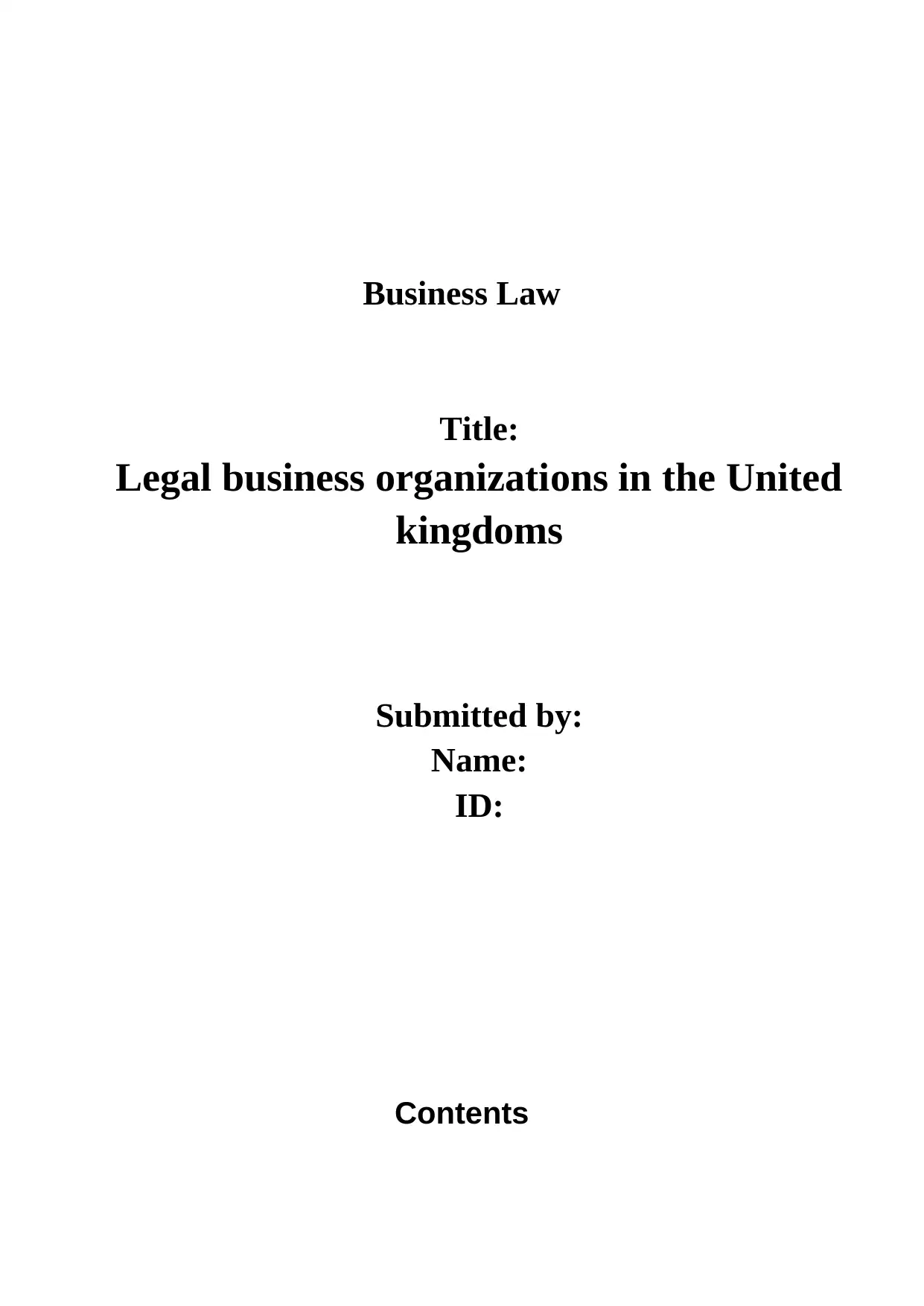
Business Law
Title:
Legal business organizations in the United
kingdoms
Submitted by:
Name:
ID:
Contents
Title:
Legal business organizations in the United
kingdoms
Submitted by:
Name:
ID:
Contents
Secure Best Marks with AI Grader
Need help grading? Try our AI Grader for instant feedback on your assignments.
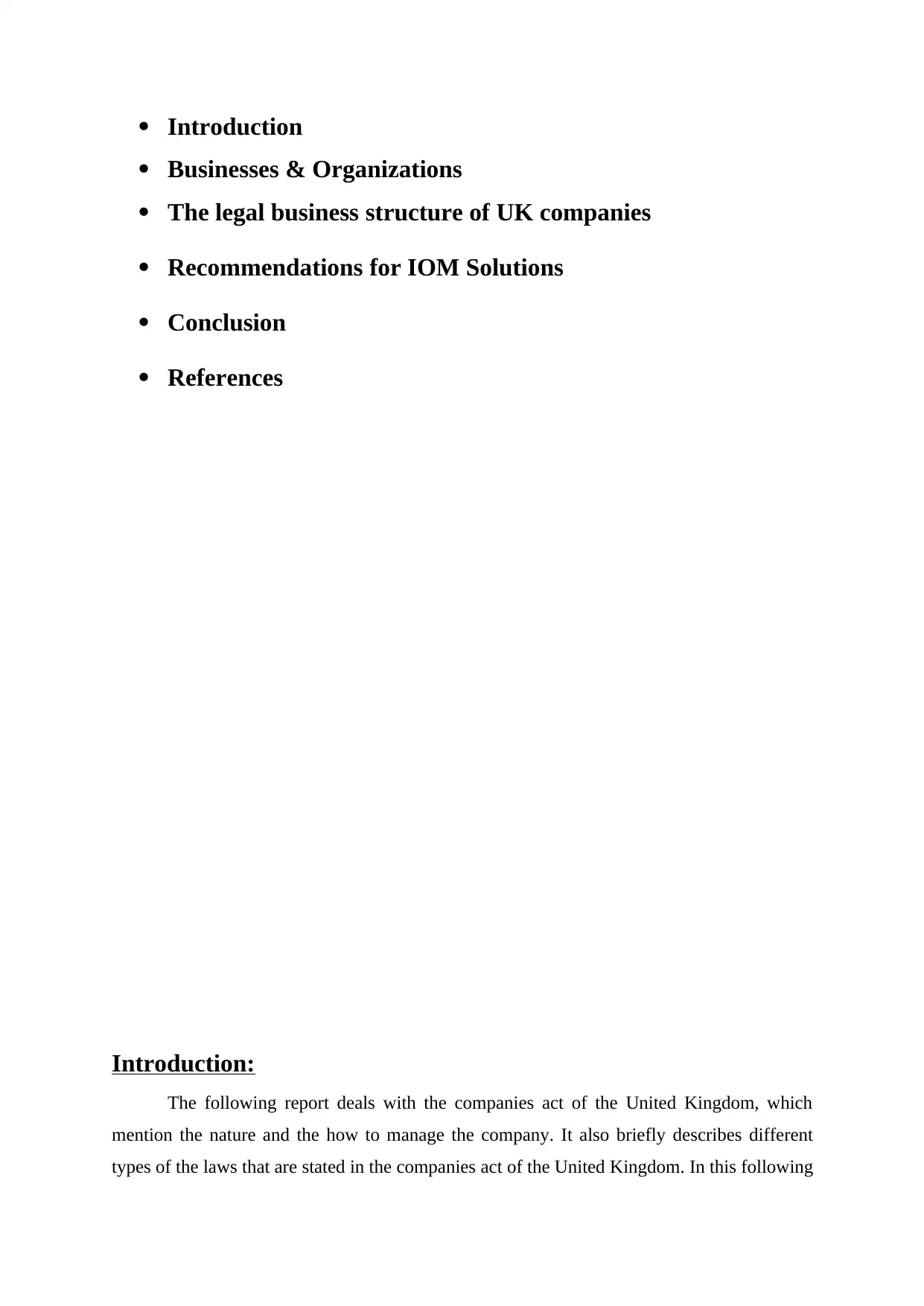
Introduction
Businesses & Organizations
The legal business structure of UK companies
Recommendations for IOM Solutions
Conclusion
References
Introduction:
The following report deals with the companies act of the United Kingdom, which
mention the nature and the how to manage the company. It also briefly describes different
types of the laws that are stated in the companies act of the United Kingdom. In this following
Businesses & Organizations
The legal business structure of UK companies
Recommendations for IOM Solutions
Conclusion
References
Introduction:
The following report deals with the companies act of the United Kingdom, which
mention the nature and the how to manage the company. It also briefly describes different
types of the laws that are stated in the companies act of the United Kingdom. In this following
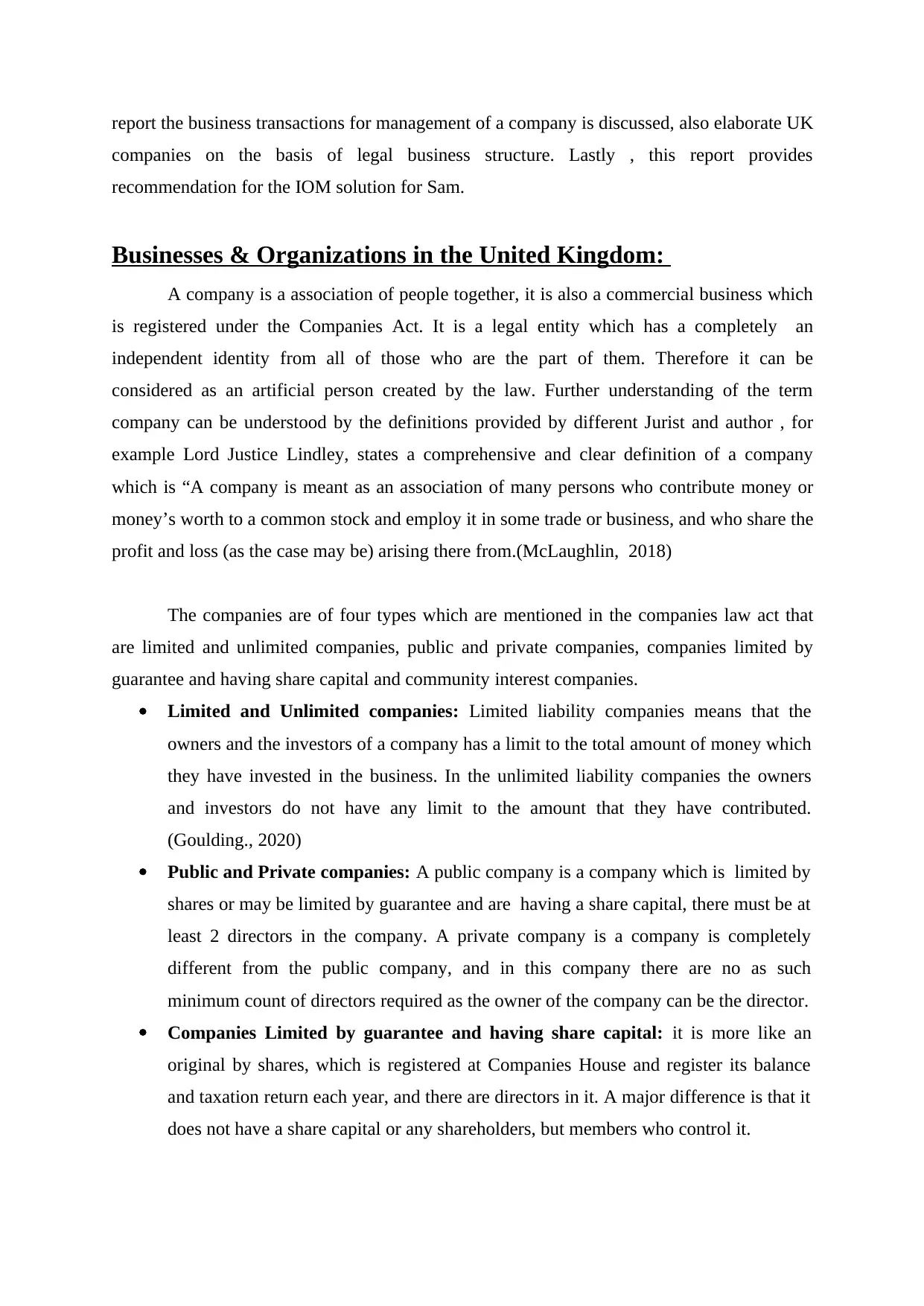
report the business transactions for management of a company is discussed, also elaborate UK
companies on the basis of legal business structure. Lastly , this report provides
recommendation for the IOM solution for Sam.
Businesses & Organizations in the United Kingdom:
A company is a association of people together, it is also a commercial business which
is registered under the Companies Act. It is a legal entity which has a completely an
independent identity from all of those who are the part of them. Therefore it can be
considered as an artificial person created by the law. Further understanding of the term
company can be understood by the definitions provided by different Jurist and author , for
example Lord Justice Lindley, states a comprehensive and clear definition of a company
which is “A company is meant as an association of many persons who contribute money or
money’s worth to a common stock and employ it in some trade or business, and who share the
profit and loss (as the case may be) arising there from.(McLaughlin, 2018)
The companies are of four types which are mentioned in the companies law act that
are limited and unlimited companies, public and private companies, companies limited by
guarantee and having share capital and community interest companies.
Limited and Unlimited companies: Limited liability companies means that the
owners and the investors of a company has a limit to the total amount of money which
they have invested in the business. In the unlimited liability companies the owners
and investors do not have any limit to the amount that they have contributed.
(Goulding., 2020)
Public and Private companies: A public company is a company which is limited by
shares or may be limited by guarantee and are having a share capital, there must be at
least 2 directors in the company. A private company is a company is completely
different from the public company, and in this company there are no as such
minimum count of directors required as the owner of the company can be the director.
Companies Limited by guarantee and having share capital: it is more like an
original by shares, which is registered at Companies House and register its balance
and taxation return each year, and there are directors in it. A major difference is that it
does not have a share capital or any shareholders, but members who control it.
companies on the basis of legal business structure. Lastly , this report provides
recommendation for the IOM solution for Sam.
Businesses & Organizations in the United Kingdom:
A company is a association of people together, it is also a commercial business which
is registered under the Companies Act. It is a legal entity which has a completely an
independent identity from all of those who are the part of them. Therefore it can be
considered as an artificial person created by the law. Further understanding of the term
company can be understood by the definitions provided by different Jurist and author , for
example Lord Justice Lindley, states a comprehensive and clear definition of a company
which is “A company is meant as an association of many persons who contribute money or
money’s worth to a common stock and employ it in some trade or business, and who share the
profit and loss (as the case may be) arising there from.(McLaughlin, 2018)
The companies are of four types which are mentioned in the companies law act that
are limited and unlimited companies, public and private companies, companies limited by
guarantee and having share capital and community interest companies.
Limited and Unlimited companies: Limited liability companies means that the
owners and the investors of a company has a limit to the total amount of money which
they have invested in the business. In the unlimited liability companies the owners
and investors do not have any limit to the amount that they have contributed.
(Goulding., 2020)
Public and Private companies: A public company is a company which is limited by
shares or may be limited by guarantee and are having a share capital, there must be at
least 2 directors in the company. A private company is a company is completely
different from the public company, and in this company there are no as such
minimum count of directors required as the owner of the company can be the director.
Companies Limited by guarantee and having share capital: it is more like an
original by shares, which is registered at Companies House and register its balance
and taxation return each year, and there are directors in it. A major difference is that it
does not have a share capital or any shareholders, but members who control it.
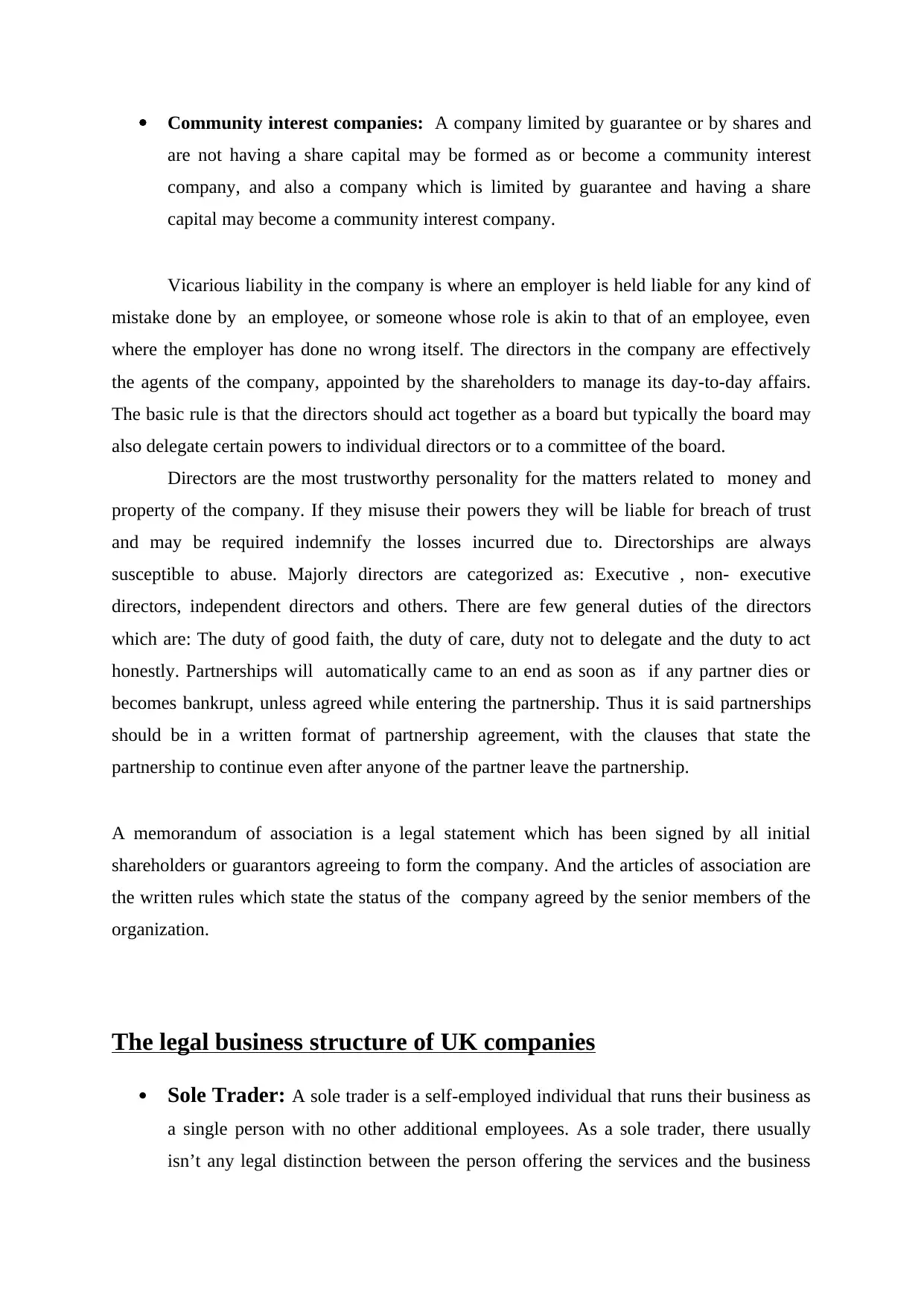
Community interest companies: A company limited by guarantee or by shares and
are not having a share capital may be formed as or become a community interest
company, and also a company which is limited by guarantee and having a share
capital may become a community interest company.
Vicarious liability in the company is where an employer is held liable for any kind of
mistake done by an employee, or someone whose role is akin to that of an employee, even
where the employer has done no wrong itself. The directors in the company are effectively
the agents of the company, appointed by the shareholders to manage its day-to-day affairs.
The basic rule is that the directors should act together as a board but typically the board may
also delegate certain powers to individual directors or to a committee of the board.
Directors are the most trustworthy personality for the matters related to money and
property of the company. If they misuse their powers they will be liable for breach of trust
and may be required indemnify the losses incurred due to. Directorships are always
susceptible to abuse. Majorly directors are categorized as: Executive , non- executive
directors, independent directors and others. There are few general duties of the directors
which are: The duty of good faith, the duty of care, duty not to delegate and the duty to act
honestly. Partnerships will automatically came to an end as soon as if any partner dies or
becomes bankrupt, unless agreed while entering the partnership. Thus it is said partnerships
should be in a written format of partnership agreement, with the clauses that state the
partnership to continue even after anyone of the partner leave the partnership.
A memorandum of association is a legal statement which has been signed by all initial
shareholders or guarantors agreeing to form the company. And the articles of association are
the written rules which state the status of the company agreed by the senior members of the
organization.
The legal business structure of UK companies
Sole Trader: A sole trader is a self-employed individual that runs their business as
a single person with no other additional employees. As a sole trader, there usually
isn’t any legal distinction between the person offering the services and the business
are not having a share capital may be formed as or become a community interest
company, and also a company which is limited by guarantee and having a share
capital may become a community interest company.
Vicarious liability in the company is where an employer is held liable for any kind of
mistake done by an employee, or someone whose role is akin to that of an employee, even
where the employer has done no wrong itself. The directors in the company are effectively
the agents of the company, appointed by the shareholders to manage its day-to-day affairs.
The basic rule is that the directors should act together as a board but typically the board may
also delegate certain powers to individual directors or to a committee of the board.
Directors are the most trustworthy personality for the matters related to money and
property of the company. If they misuse their powers they will be liable for breach of trust
and may be required indemnify the losses incurred due to. Directorships are always
susceptible to abuse. Majorly directors are categorized as: Executive , non- executive
directors, independent directors and others. There are few general duties of the directors
which are: The duty of good faith, the duty of care, duty not to delegate and the duty to act
honestly. Partnerships will automatically came to an end as soon as if any partner dies or
becomes bankrupt, unless agreed while entering the partnership. Thus it is said partnerships
should be in a written format of partnership agreement, with the clauses that state the
partnership to continue even after anyone of the partner leave the partnership.
A memorandum of association is a legal statement which has been signed by all initial
shareholders or guarantors agreeing to form the company. And the articles of association are
the written rules which state the status of the company agreed by the senior members of the
organization.
The legal business structure of UK companies
Sole Trader: A sole trader is a self-employed individual that runs their business as
a single person with no other additional employees. As a sole trader, there usually
isn’t any legal distinction between the person offering the services and the business
Secure Best Marks with AI Grader
Need help grading? Try our AI Grader for instant feedback on your assignments.
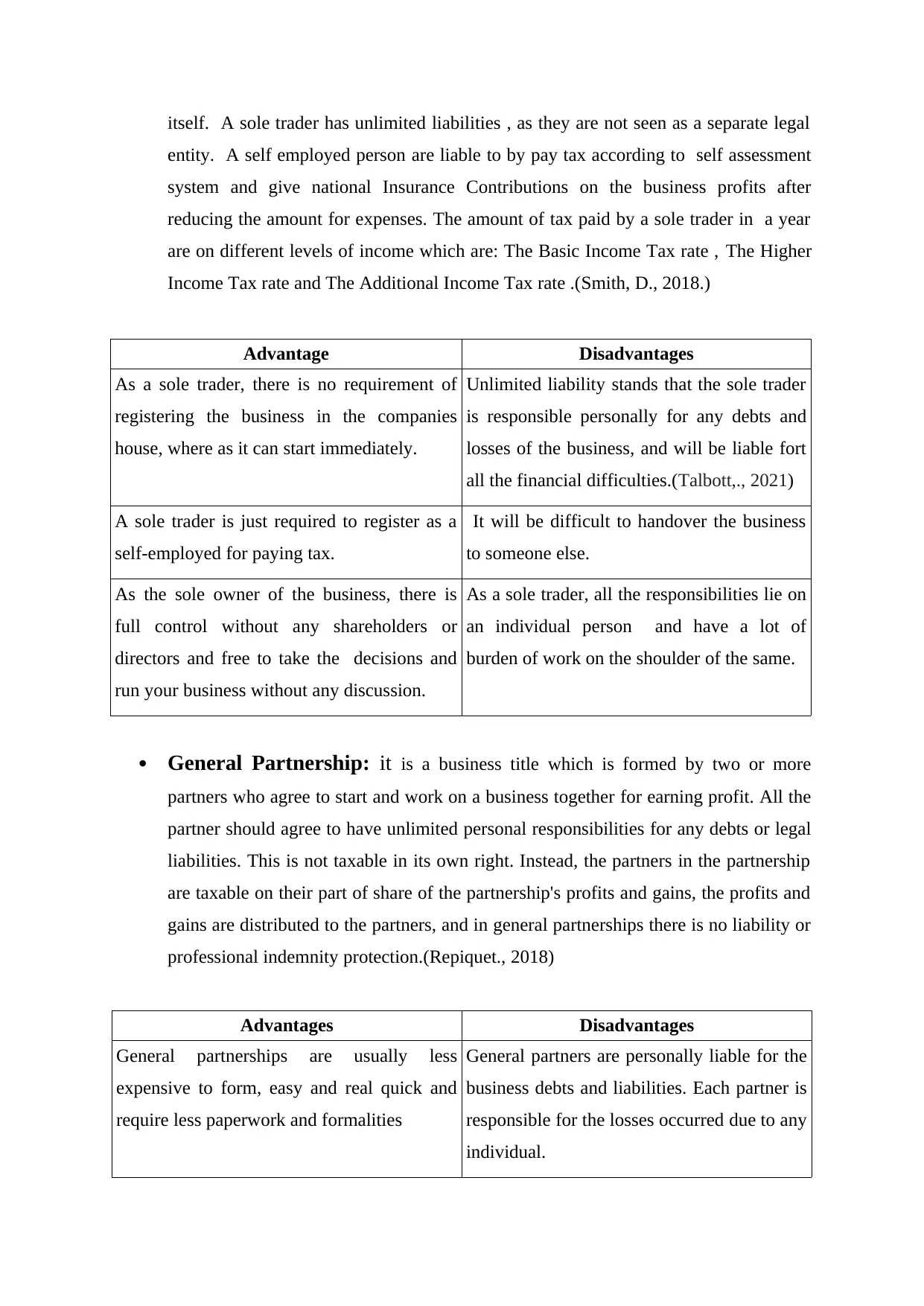
itself. A sole trader has unlimited liabilities , as they are not seen as a separate legal
entity. A self employed person are liable to by pay tax according to self assessment
system and give national Insurance Contributions on the business profits after
reducing the amount for expenses. The amount of tax paid by a sole trader in a year
are on different levels of income which are: The Basic Income Tax rate , The Higher
Income Tax rate and The Additional Income Tax rate .(Smith, D., 2018.)
Advantage Disadvantages
As a sole trader, there is no requirement of
registering the business in the companies
house, where as it can start immediately.
Unlimited liability stands that the sole trader
is responsible personally for any debts and
losses of the business, and will be liable fort
all the financial difficulties.(Talbott,., 2021)
A sole trader is just required to register as a
self-employed for paying tax.
It will be difficult to handover the business
to someone else.
As the sole owner of the business, there is
full control without any shareholders or
directors and free to take the decisions and
run your business without any discussion.
As a sole trader, all the responsibilities lie on
an individual person and have a lot of
burden of work on the shoulder of the same.
General Partnership: it is a business title which is formed by two or more
partners who agree to start and work on a business together for earning profit. All the
partner should agree to have unlimited personal responsibilities for any debts or legal
liabilities. This is not taxable in its own right. Instead, the partners in the partnership
are taxable on their part of share of the partnership's profits and gains, the profits and
gains are distributed to the partners, and in general partnerships there is no liability or
professional indemnity protection.(Repiquet., 2018)
Advantages Disadvantages
General partnerships are usually less
expensive to form, easy and real quick and
require less paperwork and formalities
General partners are personally liable for the
business debts and liabilities. Each partner is
responsible for the losses occurred due to any
individual.
entity. A self employed person are liable to by pay tax according to self assessment
system and give national Insurance Contributions on the business profits after
reducing the amount for expenses. The amount of tax paid by a sole trader in a year
are on different levels of income which are: The Basic Income Tax rate , The Higher
Income Tax rate and The Additional Income Tax rate .(Smith, D., 2018.)
Advantage Disadvantages
As a sole trader, there is no requirement of
registering the business in the companies
house, where as it can start immediately.
Unlimited liability stands that the sole trader
is responsible personally for any debts and
losses of the business, and will be liable fort
all the financial difficulties.(Talbott,., 2021)
A sole trader is just required to register as a
self-employed for paying tax.
It will be difficult to handover the business
to someone else.
As the sole owner of the business, there is
full control without any shareholders or
directors and free to take the decisions and
run your business without any discussion.
As a sole trader, all the responsibilities lie on
an individual person and have a lot of
burden of work on the shoulder of the same.
General Partnership: it is a business title which is formed by two or more
partners who agree to start and work on a business together for earning profit. All the
partner should agree to have unlimited personal responsibilities for any debts or legal
liabilities. This is not taxable in its own right. Instead, the partners in the partnership
are taxable on their part of share of the partnership's profits and gains, the profits and
gains are distributed to the partners, and in general partnerships there is no liability or
professional indemnity protection.(Repiquet., 2018)
Advantages Disadvantages
General partnerships are usually less
expensive to form, easy and real quick and
require less paperwork and formalities
General partners are personally liable for the
business debts and liabilities. Each partner is
responsible for the losses occurred due to any
individual.
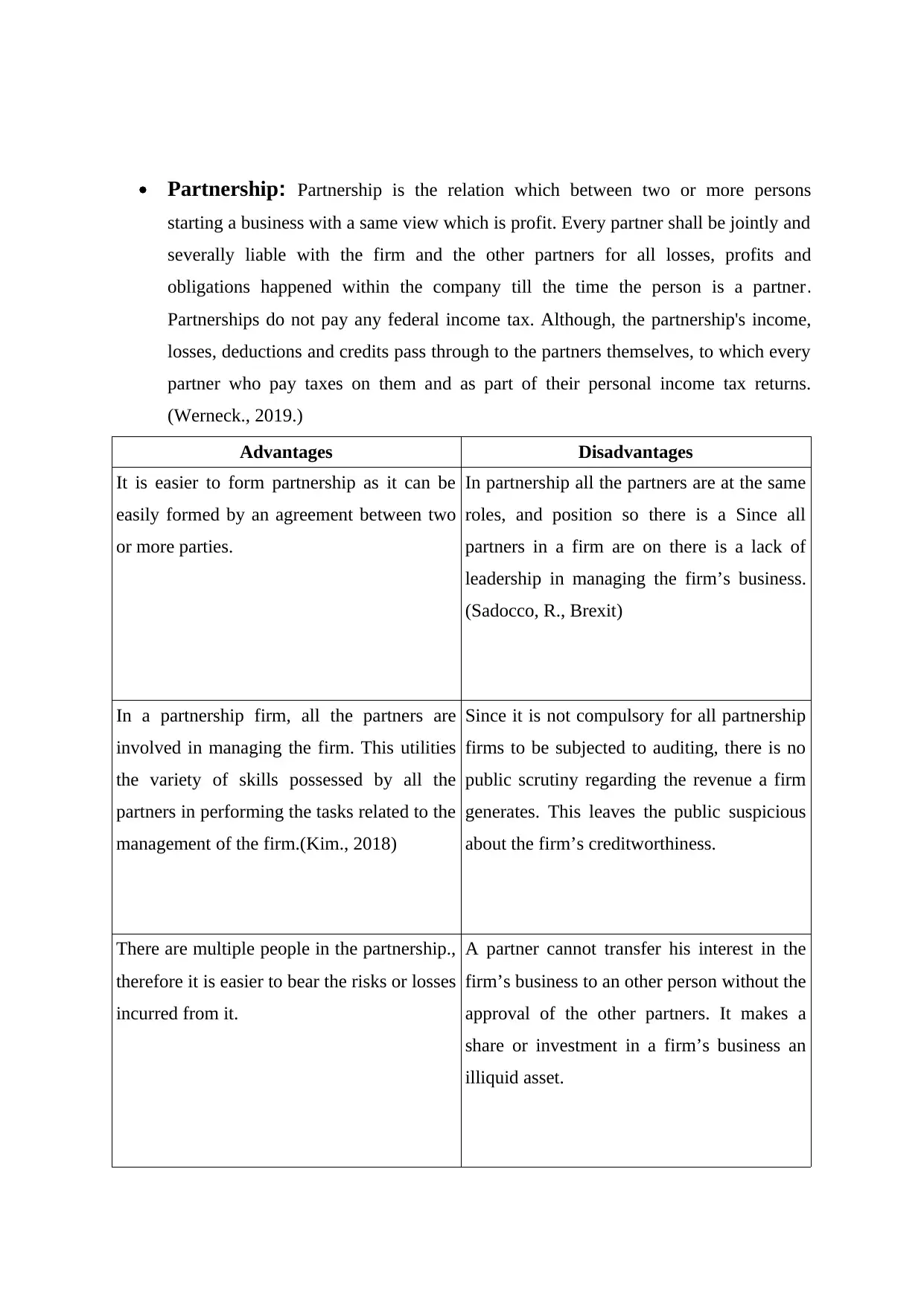
Partnership: Partnership is the relation which between two or more persons
starting a business with a same view which is profit. Every partner shall be jointly and
severally liable with the firm and the other partners for all losses, profits and
obligations happened within the company till the time the person is a partner.
Partnerships do not pay any federal income tax. Although, the partnership's income,
losses, deductions and credits pass through to the partners themselves, to which every
partner who pay taxes on them and as part of their personal income tax returns.
(Werneck., 2019.)
Advantages Disadvantages
It is easier to form partnership as it can be
easily formed by an agreement between two
or more parties.
In partnership all the partners are at the same
roles, and position so there is a Since all
partners in a firm are on there is a lack of
leadership in managing the firm’s business.
(Sadocco, R., Brexit)
In a partnership firm, all the partners are
involved in managing the firm. This utilities
the variety of skills possessed by all the
partners in performing the tasks related to the
management of the firm.(Kim., 2018)
Since it is not compulsory for all partnership
firms to be subjected to auditing, there is no
public scrutiny regarding the revenue a firm
generates. This leaves the public suspicious
about the firm’s creditworthiness.
There are multiple people in the partnership.,
therefore it is easier to bear the risks or losses
incurred from it.
A partner cannot transfer his interest in the
firm’s business to an other person without the
approval of the other partners. It makes a
share or investment in a firm’s business an
illiquid asset.
starting a business with a same view which is profit. Every partner shall be jointly and
severally liable with the firm and the other partners for all losses, profits and
obligations happened within the company till the time the person is a partner.
Partnerships do not pay any federal income tax. Although, the partnership's income,
losses, deductions and credits pass through to the partners themselves, to which every
partner who pay taxes on them and as part of their personal income tax returns.
(Werneck., 2019.)
Advantages Disadvantages
It is easier to form partnership as it can be
easily formed by an agreement between two
or more parties.
In partnership all the partners are at the same
roles, and position so there is a Since all
partners in a firm are on there is a lack of
leadership in managing the firm’s business.
(Sadocco, R., Brexit)
In a partnership firm, all the partners are
involved in managing the firm. This utilities
the variety of skills possessed by all the
partners in performing the tasks related to the
management of the firm.(Kim., 2018)
Since it is not compulsory for all partnership
firms to be subjected to auditing, there is no
public scrutiny regarding the revenue a firm
generates. This leaves the public suspicious
about the firm’s creditworthiness.
There are multiple people in the partnership.,
therefore it is easier to bear the risks or losses
incurred from it.
A partner cannot transfer his interest in the
firm’s business to an other person without the
approval of the other partners. It makes a
share or investment in a firm’s business an
illiquid asset.
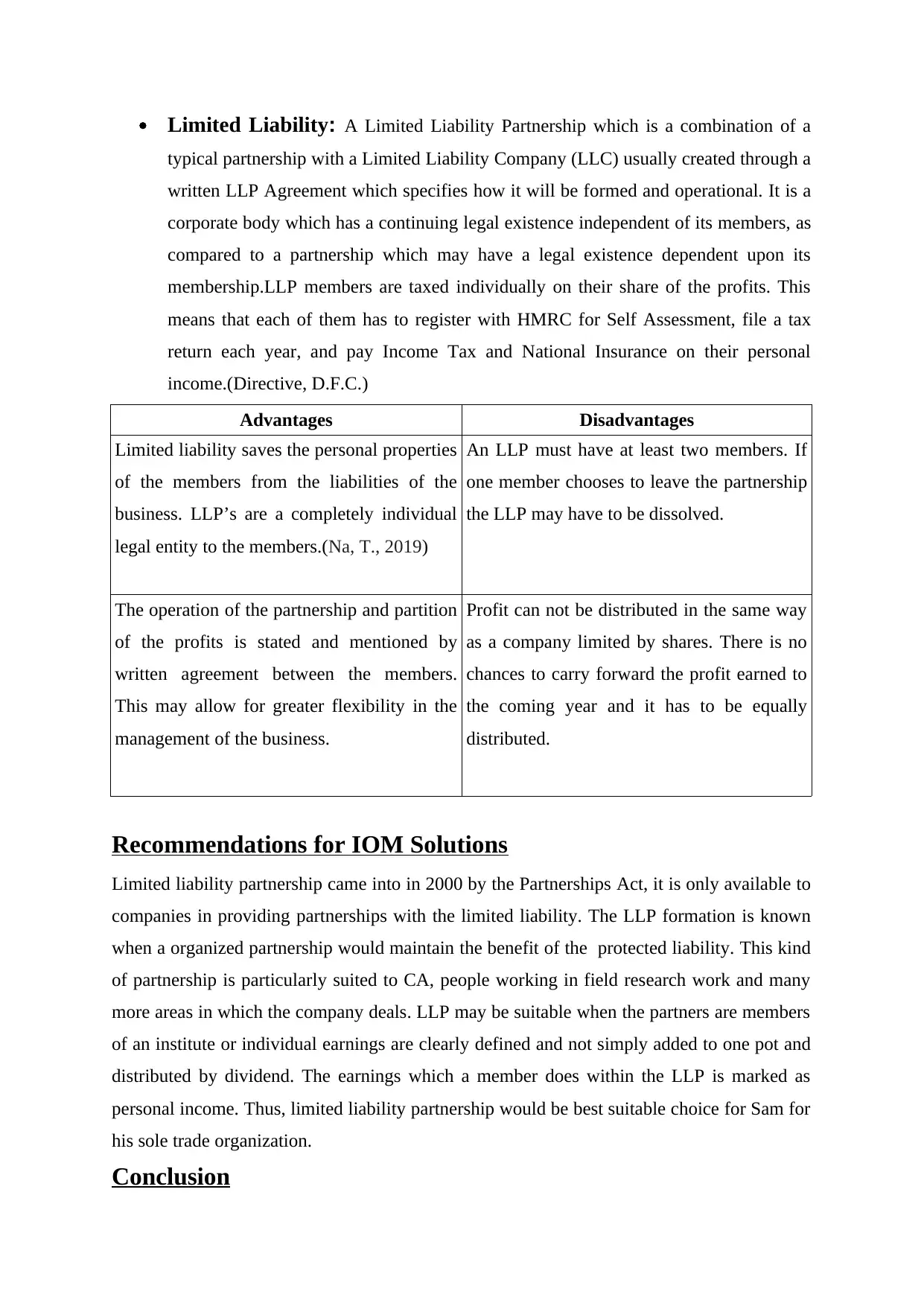
Limited Liability: A Limited Liability Partnership which is a combination of a
typical partnership with a Limited Liability Company (LLC) usually created through a
written LLP Agreement which specifies how it will be formed and operational. It is a
corporate body which has a continuing legal existence independent of its members, as
compared to a partnership which may have a legal existence dependent upon its
membership.LLP members are taxed individually on their share of the profits. This
means that each of them has to register with HMRC for Self Assessment, file a tax
return each year, and pay Income Tax and National Insurance on their personal
income.(Directive, D.F.C.)
Advantages Disadvantages
Limited liability saves the personal properties
of the members from the liabilities of the
business. LLP’s are a completely individual
legal entity to the members.(Na, T., 2019)
An LLP must have at least two members. If
one member chooses to leave the partnership
the LLP may have to be dissolved.
The operation of the partnership and partition
of the profits is stated and mentioned by
written agreement between the members.
This may allow for greater flexibility in the
management of the business.
Profit can not be distributed in the same way
as a company limited by shares. There is no
chances to carry forward the profit earned to
the coming year and it has to be equally
distributed.
Recommendations for IOM Solutions
Limited liability partnership came into in 2000 by the Partnerships Act, it is only available to
companies in providing partnerships with the limited liability. The LLP formation is known
when a organized partnership would maintain the benefit of the protected liability. This kind
of partnership is particularly suited to CA, people working in field research work and many
more areas in which the company deals. LLP may be suitable when the partners are members
of an institute or individual earnings are clearly defined and not simply added to one pot and
distributed by dividend. The earnings which a member does within the LLP is marked as
personal income. Thus, limited liability partnership would be best suitable choice for Sam for
his sole trade organization.
Conclusion
typical partnership with a Limited Liability Company (LLC) usually created through a
written LLP Agreement which specifies how it will be formed and operational. It is a
corporate body which has a continuing legal existence independent of its members, as
compared to a partnership which may have a legal existence dependent upon its
membership.LLP members are taxed individually on their share of the profits. This
means that each of them has to register with HMRC for Self Assessment, file a tax
return each year, and pay Income Tax and National Insurance on their personal
income.(Directive, D.F.C.)
Advantages Disadvantages
Limited liability saves the personal properties
of the members from the liabilities of the
business. LLP’s are a completely individual
legal entity to the members.(Na, T., 2019)
An LLP must have at least two members. If
one member chooses to leave the partnership
the LLP may have to be dissolved.
The operation of the partnership and partition
of the profits is stated and mentioned by
written agreement between the members.
This may allow for greater flexibility in the
management of the business.
Profit can not be distributed in the same way
as a company limited by shares. There is no
chances to carry forward the profit earned to
the coming year and it has to be equally
distributed.
Recommendations for IOM Solutions
Limited liability partnership came into in 2000 by the Partnerships Act, it is only available to
companies in providing partnerships with the limited liability. The LLP formation is known
when a organized partnership would maintain the benefit of the protected liability. This kind
of partnership is particularly suited to CA, people working in field research work and many
more areas in which the company deals. LLP may be suitable when the partners are members
of an institute or individual earnings are clearly defined and not simply added to one pot and
distributed by dividend. The earnings which a member does within the LLP is marked as
personal income. Thus, limited liability partnership would be best suitable choice for Sam for
his sole trade organization.
Conclusion
Paraphrase This Document
Need a fresh take? Get an instant paraphrase of this document with our AI Paraphraser
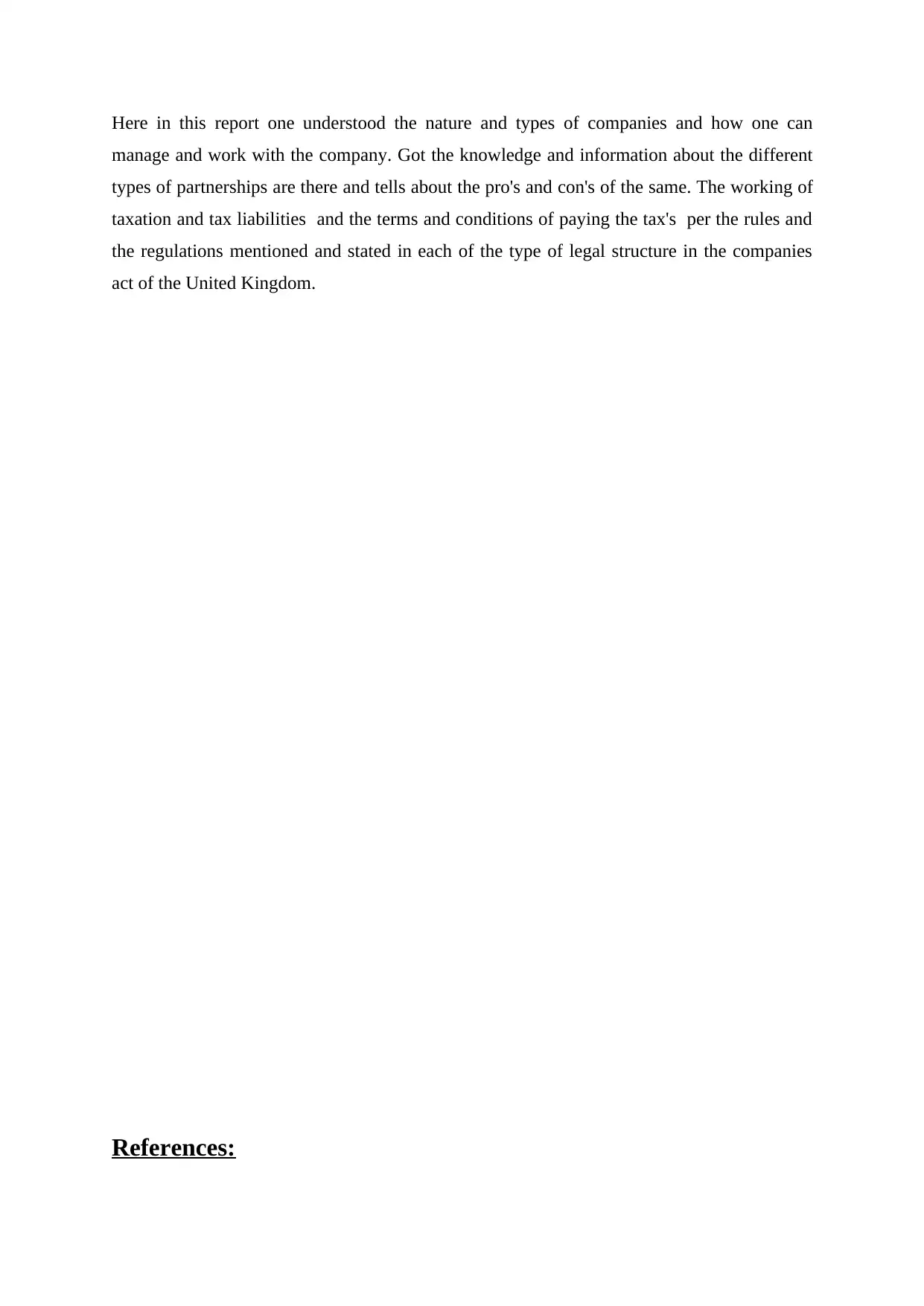
Here in this report one understood the nature and types of companies and how one can
manage and work with the company. Got the knowledge and information about the different
types of partnerships are there and tells about the pro's and con's of the same. The working of
taxation and tax liabilities and the terms and conditions of paying the tax's per the rules and
the regulations mentioned and stated in each of the type of legal structure in the companies
act of the United Kingdom.
References:
manage and work with the company. Got the knowledge and information about the different
types of partnerships are there and tells about the pro's and con's of the same. The working of
taxation and tax liabilities and the terms and conditions of paying the tax's per the rules and
the regulations mentioned and stated in each of the type of legal structure in the companies
act of the United Kingdom.
References:
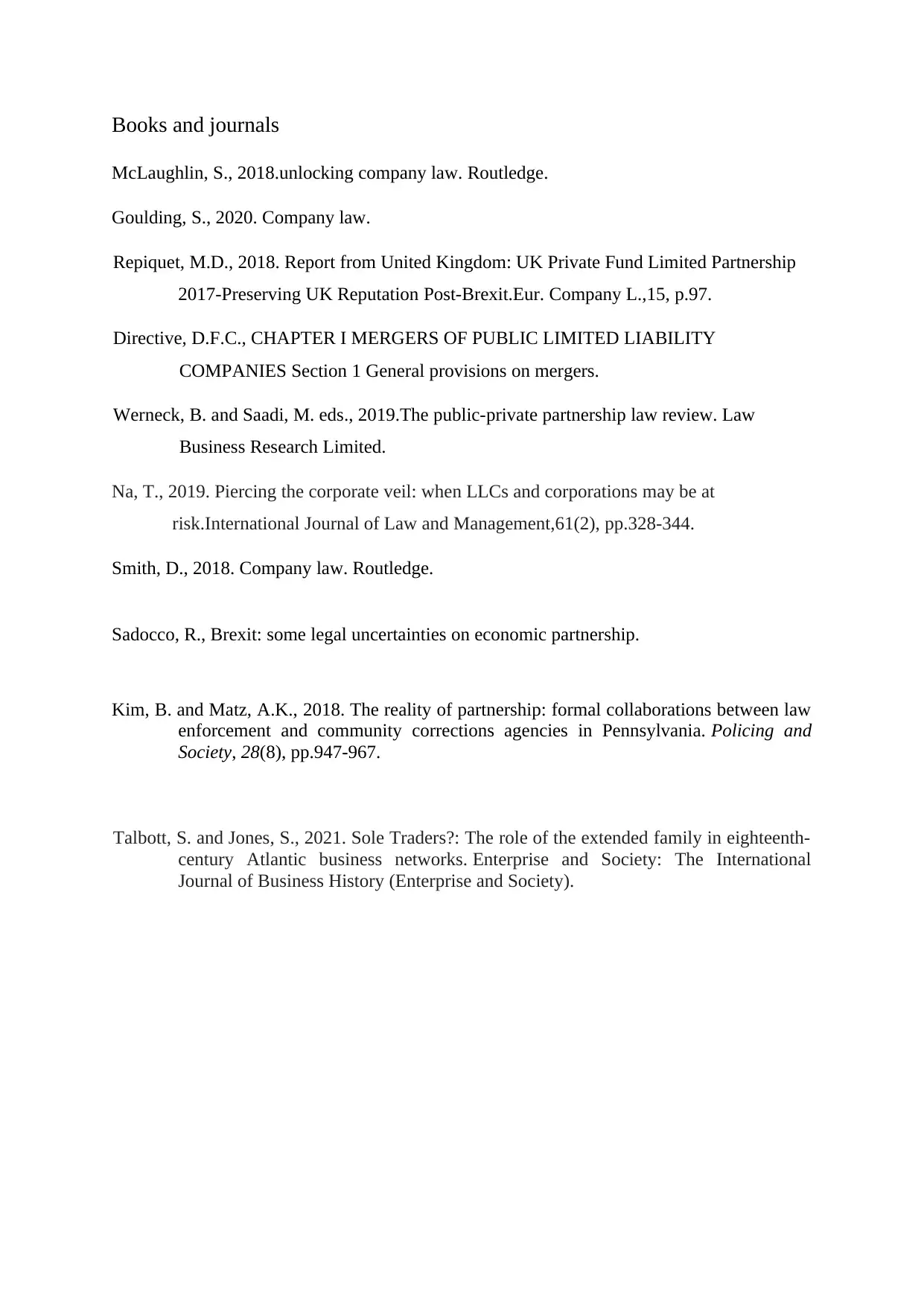
Books and journals
McLaughlin, S., 2018.unlocking company law. Routledge.
Goulding, S., 2020. Company law.
Repiquet, M.D., 2018. Report from United Kingdom: UK Private Fund Limited Partnership
2017-Preserving UK Reputation Post-Brexit.Eur. Company L.,15, p.97.
Directive, D.F.C., CHAPTER I MERGERS OF PUBLIC LIMITED LIABILITY
COMPANIES Section 1 General provisions on mergers.
Werneck, B. and Saadi, M. eds., 2019.The public-private partnership law review. Law
Business Research Limited.
Na, T., 2019. Piercing the corporate veil: when LLCs and corporations may be at
risk.International Journal of Law and Management,61(2), pp.328-344.
Smith, D., 2018. Company law. Routledge.
Sadocco, R., Brexit: some legal uncertainties on economic partnership.
Kim, B. and Matz, A.K., 2018. The reality of partnership: formal collaborations between law
enforcement and community corrections agencies in Pennsylvania. Policing and
Society, 28(8), pp.947-967.
Talbott, S. and Jones, S., 2021. Sole Traders?: The role of the extended family in eighteenth-
century Atlantic business networks. Enterprise and Society: The International
Journal of Business History (Enterprise and Society).
McLaughlin, S., 2018.unlocking company law. Routledge.
Goulding, S., 2020. Company law.
Repiquet, M.D., 2018. Report from United Kingdom: UK Private Fund Limited Partnership
2017-Preserving UK Reputation Post-Brexit.Eur. Company L.,15, p.97.
Directive, D.F.C., CHAPTER I MERGERS OF PUBLIC LIMITED LIABILITY
COMPANIES Section 1 General provisions on mergers.
Werneck, B. and Saadi, M. eds., 2019.The public-private partnership law review. Law
Business Research Limited.
Na, T., 2019. Piercing the corporate veil: when LLCs and corporations may be at
risk.International Journal of Law and Management,61(2), pp.328-344.
Smith, D., 2018. Company law. Routledge.
Sadocco, R., Brexit: some legal uncertainties on economic partnership.
Kim, B. and Matz, A.K., 2018. The reality of partnership: formal collaborations between law
enforcement and community corrections agencies in Pennsylvania. Policing and
Society, 28(8), pp.947-967.
Talbott, S. and Jones, S., 2021. Sole Traders?: The role of the extended family in eighteenth-
century Atlantic business networks. Enterprise and Society: The International
Journal of Business History (Enterprise and Society).
1 out of 9
Related Documents
Your All-in-One AI-Powered Toolkit for Academic Success.
+13062052269
info@desklib.com
Available 24*7 on WhatsApp / Email
![[object Object]](/_next/static/media/star-bottom.7253800d.svg)
Unlock your academic potential
© 2024 | Zucol Services PVT LTD | All rights reserved.



